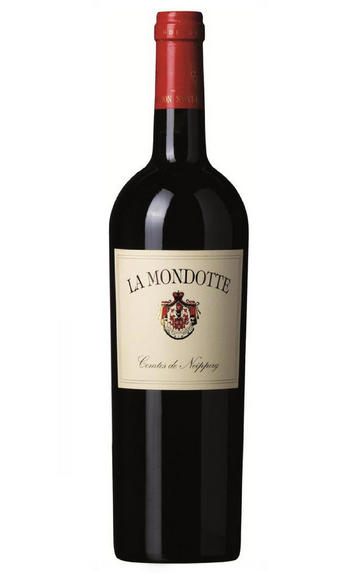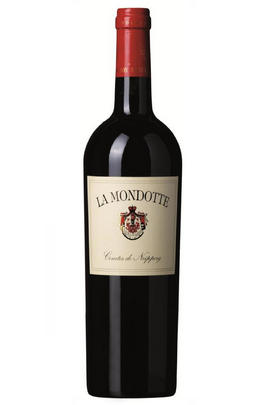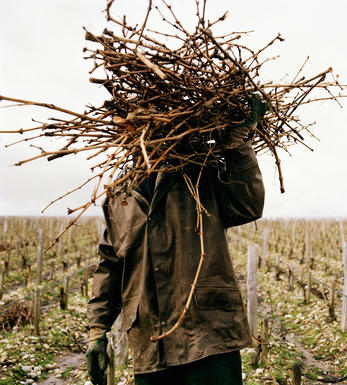
2020 La Mondotte, St Emilion, Bordeaux

Critics reviews
The 2020 La Mondotte has altered since tasting it from barrel, closing in a little, becoming less sensual and more "serious". Blackberry intermingles with raspberry coulis, cedar and a very subtle star anis scent with superb delineation and focus. The palate is medium-bodied with fine-grain tannins. Like the aromatics, it has become more intellectual during its élevage, more saline, slightly granular in texture with a harmonious yet understated finish that lingers long in the mouth. Sophisticated.
Drink 2027 - 2050
Neil Martin, Vinous.com (February 2023)
The 2020 La Mondotte is fabulous. Rich, heady and exotic, the 2020 offers up copious blackberry, blueberry, mocha, liquorice, lavender and spice, with more savoury and mineral notes that appear over time. Like all of Stephan von Neipperg's 2020s, La Mondotte marries fruit intensity and structure in brilliant style. As always, La Mondotte is a pretty full throttle Saint-Émilion, but the excesses of the past have been tamed.
Drink 2030 - 2045
Antonio Galloni, Vinous.com (February 2023)
A yield of 36hl/ha.
Ruby and violet-laced colour, glass-staining berry fruit, clear limestone influence, sappy and a little austere, slate and juice. Muscular in its colour and aromatics on the attack, then it contracts halfway through the palate and the grippy tannins come into play. Good stuff.
Drink 2028 - 2040
Jane Anson, Decanter.com (March 2021)
Tasted blind.
Deepest crimson. Dark, rich, but fresh black fruit. Lots of freshness here, and the tannins are already very fine. Lovely freshness and depth. Long and harmonious.
Drink 2028 - 2040
Julia Harding MW, JancisRobinson.com (February 2024)
I typically have a weakness for Canon-la-Gaffelière, with its high percentage of Cabernet Franc, in the Von Neipperg portfolio. But this year, it's the 2020 La Mondotte that takes centre stage, offering up aromas of dark berries, plums, liquorice, incense and vine smoke, followed by a medium to full-bodied, layered and vibrant palate of striking harmony and concentration. It's the most seamless, complete wine I've ever tasted from this brilliant clay-limestone terroir.
Drink 2025 - 2050
William Kelley, Wine Advocate (April 2023)
Blackberries, blueberries and flowers such as lavender and dark roses on the nose. Dried flowers as well. Feels medium-bodied with seamless tannins that spread across the palate. Savory and agile with a weightless feel. Hints of white pepper and salt. Makes you want to taste it.
Better after 2026
James Suckling, JamesSuckling.com (November 2023)
Just about pure perfection, the 2020 La Mondotte comes from a tiny parcel of limestone soils on the upper plateau, not far from Troplong Mondot. Mostly Merlot with a small amount of Cabernet Franc, its deep purple hue is followed by a brilliant bouquet of crème de cassis, crushed stone, graphite, mulled black cherries, and hints of truffle. Full-bodied, incredibly elegant yet also concentrated and flawlessly balanced, it's as good as anything in the vintage. Give bottles 4-6 years in the cellar, count yourself lucky, and enjoy over the following 2-3 decades.
Drink 2027 - 2052
Jeb Dunnuck, JebDunnuck.com (March 2023)
About this WINE

La Mondotte
La Mondotte is a tiny 4.5 hectare vineyard located just east of the St-Emilion limestone plateau between Troplong-Mondot and Tertre-Rôteboeuf. It is owned by Count Stefan von Neipperg who also owns Canon-La-Gaffelière.
In the early 1990s he tried to officially merge the vineyards of Mondotte and Canon-La-Gaffelière but was thwarted in his efforts by the governing authorities on the grounds that Canon-La-Gaffelière was a St. Emilion Grand Cru Classé and Château La Mondotte was not. Incensed, he set out to prove the authorities wrong by installing a fermentation facility at La Mondotte and showing what its terroir was capable of producing.
La Mondotte's clay-rich soils and the almost perfect aspect of the steep vineyards produce super-ripe Merlot grapes and a smaller proportion of Cabernet Franc grapes. These are fermented and then matured in 100% new oak barrels for 12-18 months.
La Mondotte produces extraordinarily rich, opulent and intense and are now increasingly difficult to find.

St Émilion
St Émilion is one of Bordeaux's largest producing appellations, producing more wine than Listrac, Moulis, St Estèphe, Pauillac, St Julien and Margaux put together. St Emilion has been producing wine for longer than the Médoc but its lack of accessibility to Bordeaux's port and market-restricted exports to mainland Europe meant the region initially did not enjoy the commercial success that funded the great châteaux of the Left Bank.
St Émilion itself is the prettiest of Bordeaux's wine towns, perched on top of the steep limestone slopes upon which many of the region's finest vineyards are situated. However, more than half of the appellation's vineyards lie on the plain between the town and the Dordogne River on sandy, alluvial soils with a sprinkling of gravel.
Further diversity is added by a small, complex gravel bed to the north-east of the region on the border with Pomerol. Atypically for St Émilion, this allows Cabernet Franc and, to a lesser extent, Cabernet Sauvignon to prosper and defines the personality of the great wines such as Ch. Cheval Blanc.
In the early 1990s there was an explosion of experimentation and evolution, leading to the rise of the garagistes, producers of deeply-concentrated wines made in very small quantities and offered at high prices. The appellation is also surrounded by four satellite appellations, Montagne, Lussac, Puisseguin and St. Georges, which enjoy a family similarity but not the complexity of the best wines.
St Émilion was first officially classified in 1954, and is the most meritocratic classification system in Bordeaux, as it is regularly amended. The most recent revision of the classification was in 2012

Cabernet Sauvignon Blend
Cabernet Sauvignon lends itself particularly well in blends with Merlot. This is actually the archetypal Bordeaux blend, though in different proportions in the sub-regions and sometimes topped up with Cabernet Franc, Malbec, and Petit Verdot.
In the Médoc and Graves the percentage of Cabernet Sauvignon in the blend can range from 95% (Mouton-Rothschild) to as low as 40%. It is particularly suited to the dry, warm, free- draining, gravel-rich soils and is responsible for the redolent cassis characteristics as well as the depth of colour, tannic structure and pronounced acidity of Médoc wines. However 100% Cabernet Sauvignon wines can be slightly hollow-tasting in the middle palate and Merlot with its generous, fleshy fruit flavours acts as a perfect foil by filling in this cavity.
In St-Emilion and Pomerol, the blends are Merlot dominated as Cabernet Sauvignon can struggle to ripen there - when it is included, it adds structure and body to the wine. Sassicaia is the most famous Bordeaux blend in Italy and has spawned many imitations, whereby the blend is now firmly established in the New World and particularly in California and Australia.


Buying options
Add to wishlist
Description
The 2020 La Mondotte has altered since tasting it from barrel, closing in a little, becoming less sensual and more "serious". Blackberry intermingles with raspberry coulis, cedar and a very subtle star anis scent with superb delineation and focus. The palate is medium-bodied with fine-grain tannins. Like the aromatics, it has become more intellectual during its élevage, more saline, slightly granular in texture with a harmonious yet understated finish that lingers long in the mouth. Sophisticated.
Drink 2027 - 2050
Neil Martin, Vinous.com (February 2023)
wine at a glance
Delivery and quality guarantee